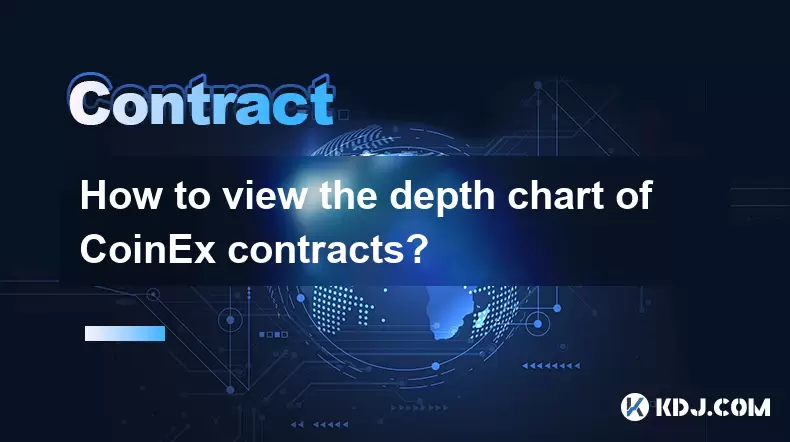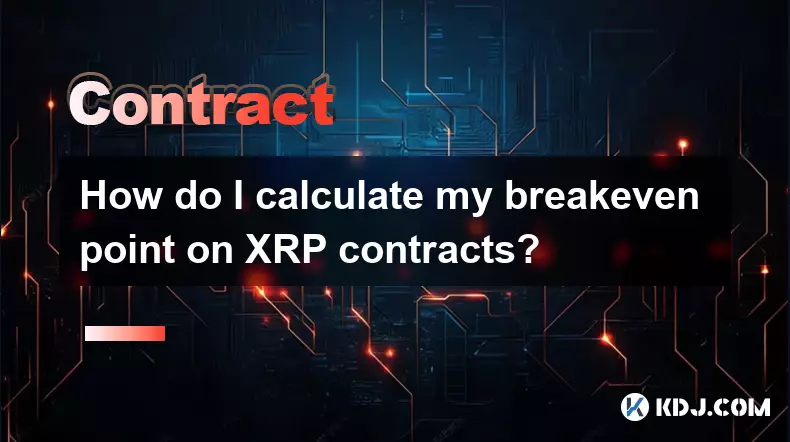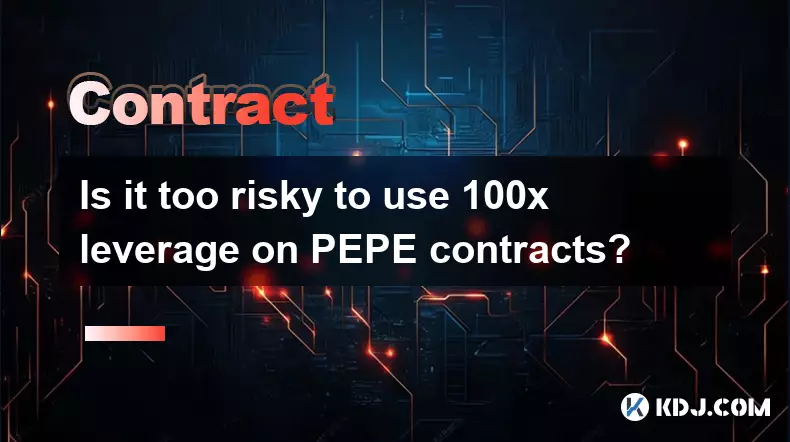-
 bitcoin
bitcoin $121833.232455 USD
-0.63% -
 ethereum
ethereum $4394.437030 USD
-2.00% -
 tether
tether $1.000570 USD
0.04% -
 bnb
bnb $1255.553465 USD
-3.73% -
 xrp
xrp $2.814944 USD
-1.59% -
 solana
solana $221.835346 USD
-2.40% -
 usd-coin
usd-coin $0.999869 USD
0.01% -
 dogecoin
dogecoin $0.249495 USD
-1.32% -
 tron
tron $0.336905 USD
-1.24% -
 cardano
cardano $0.816464 USD
-1.69% -
 chainlink
chainlink $22.130946 USD
-1.27% -
 hyperliquid
hyperliquid $44.208522 USD
-3.46% -
 ethena-usde
ethena-usde $1.000521 USD
0.02% -
 sui
sui $3.422897 USD
-2.51% -
 stellar
stellar $0.380164 USD
-1.31%
How to view the depth chart of CoinEx contracts?
The depth chart on CoinEx displays real-time buy and sell orders, helping traders analyze liquidity, identify support/resistance levels, and make informed trading decisions.
Jun 14, 2025 at 08:08 am

What is a Depth Chart in CoinEx Contracts?
A depth chart, also known as an order book depth chart, is a visual representation of the buy and sell orders for a specific cryptocurrency contract on the CoinEx platform. It provides traders with insights into market liquidity, price levels where large orders are placed, and potential support or resistance zones. Understanding how to interpret this chart can significantly enhance your trading decisions.
For users engaged in CoinEx futures trading, the depth chart plays a crucial role in gauging market sentiment and identifying possible entry or exit points. It reflects the current supply and demand at various price levels, which helps traders anticipate short-term price movements.
How to Access the Depth Chart on CoinEx
To begin viewing the depth chart on CoinEx, you must first log in to your account and navigate to the Contracts section of the platform. Once there, follow these steps:
- Select the cryptocurrency contract pair you're interested in (e.g., BTC/USDT).
- Locate the trading interface, where multiple tools and charts are available.
- On the right-hand side or beneath the main price chart, look for the Depth Chart section.
This chart typically appears as a two-color graph — green for buy orders and red for sell orders — indicating the cumulative volume at each price level. The horizontal axis shows the amount of contracts or coins, while the vertical axis represents the price.
Interpreting Buy and Sell Walls on the Depth Chart
The buy wall refers to a cluster of large buy orders at or below the current market price, while the sell wall indicates a concentration of sell orders at or above the current price. These walls can signal strong support or resistance levels.
- A thick buy wall suggests that many traders are willing to buy at that price, potentially preventing further price drops.
- A thick sell wall implies heavy selling pressure, which might cap upward movement.
Traders often use these walls to identify manipulation attempts or genuine market interest. A sudden disappearance of a large wall could indicate a spoofing tactic used by institutional players.
Using the Depth Chart for Entry and Exit Decisions
When analyzing the depth chart, it's important to consider the liquidity distribution around the current price. If the order book is heavily weighted towards one side, it may influence how quickly the price moves in that direction.
- If the bid side (buy orders) has more volume near the current price, it could mean buyers are more aggressive.
- Conversely, if the ask side (sell orders) dominates, sellers might push the price down.
For example, before entering a long position, a trader might wait for a breakout above a significant sell wall to confirm buying momentum. Similarly, when exiting a trade, aligning with strong bid clusters ensures faster execution without slippage.
Customizing the Depth Chart Settings on CoinEx
CoinEx allows users to customize their depth chart settings to suit individual trading styles. Some options include:
- Adjusting the price range displayed on the chart.
- Changing the aggregation level of orders (showing all individual orders or grouped by price).
- Modifying the color scheme for better visibility.
These customization features help traders filter out noise and focus on relevant data. For instance, changing the aggregation level can reveal hidden liquidity that isn't immediately visible in a standard view.
It’s also possible to overlay the depth chart onto the main candlestick chart for a more comprehensive analysis. This feature enables traders to correlate price action with order book dynamics in real time.
Advanced Tips for Reading the Depth Chart
Experienced traders often combine depth chart analysis with other technical indicators like volume, moving averages, and order flow. Here are some advanced tips:
- Watch for imbalances between buy and sell volumes just before major news events.
- Use the depth chart to detect hidden orders that aren’t displayed in the standard order book.
- Compare the depth chart across different exchanges to spot arbitrage opportunities.
By integrating depth chart analysis with broader market context, traders can make more informed decisions. For example, a sudden spike in buy volume at a key support level might be a sign of a potential reversal.
Frequently Asked Questions
Q: Can I view the depth chart for all cryptocurrency contracts on CoinEx?Yes, CoinEx provides depth chart functionality for all listed futures contracts. You can access it directly from the trading interface of any active contract pair.
Q: Why does the depth chart sometimes show gaps or irregularities?Gaps in the depth chart usually reflect missing order sizes at certain price levels. They can occur due to rapid price movements or low liquidity at those levels.
Q: Is the depth chart updated in real-time on CoinEx?Yes, the depth chart on CoinEx updates in real-time as new orders are placed or canceled. However, during high volatility periods, slight delays may occur due to network congestion.
Q: Does CoinEx offer historical depth chart data?Currently, CoinEx does not provide historical depth chart data within its native interface. Traders who require such data may need to use third-party tools or APIs.
Disclaimer:info@kdj.com
The information provided is not trading advice. kdj.com does not assume any responsibility for any investments made based on the information provided in this article. Cryptocurrencies are highly volatile and it is highly recommended that you invest with caution after thorough research!
If you believe that the content used on this website infringes your copyright, please contact us immediately (info@kdj.com) and we will delete it promptly.
- Morpho Crypto: Rebuilding Ethereum Lending in the DeFi Landscape
- 2025-10-10 14:45:14
- TT Jagannathan: The Prestige Founder Who Revolutionized Indian Kitchens
- 2025-10-10 12:25:15
- Bitcoin's Open Interest Dip: What's the Deal?
- 2025-10-10 12:25:15
- Dogecoin, Litecoin, and BlockDAG: Crypto's Old Guard Meets the New Kid
- 2025-10-10 12:30:02
- Bitcoin's Sell-Offs and Momentum Swings: What's a New Yorker to Do?
- 2025-10-10 15:05:12
- MOBU BTC: Why MoonBull Could Be Your Next Crypto Obsession
- 2025-10-10 12:45:14
Related knowledge

How to calculate the ROI for Ethereum contracts?
Oct 09,2025 at 04:36pm
Understanding Ethereum Contract ROI Basics1. Return on Investment (ROI) for Ethereum contracts begins with tracking the initial capital deployed into ...

How do I calculate my breakeven point on XRP contracts?
Oct 09,2025 at 08:36pm
Understanding the Breakeven Point in XRP Futures TradingCalculating the breakeven point for XRP contracts is essential for traders who engage in futur...

How to place a take-profit order for Dogecoin contracts?
Oct 10,2025 at 05:01am
Understanding Take-Profit Orders in Dogecoin Futures Trading1. A take-profit order is a tool used by traders to automatically close a position when th...

What are the settlement procedures for XRP contracts?
Oct 09,2025 at 04:01pm
Understanding XRP Futures and Derivative Contracts1. XRP derivative contracts are typically offered by cryptocurrency exchanges that support margin tr...

How to reduce trading fees for Bitcoin contracts?
Oct 09,2025 at 02:37pm
Understanding Bitcoin Contract Trading Fees1. Trading fees on Bitcoin contracts are typically charged by exchanges for executing buy and sell orders. ...

Is it too risky to use 100x leverage on PEPE contracts?
Oct 09,2025 at 04:18pm
Understanding 100x Leverage in PEPE Contracts1. Trading PEPE contracts with 100x leverage allows traders to control a much larger position using a sma...

How to calculate the ROI for Ethereum contracts?
Oct 09,2025 at 04:36pm
Understanding Ethereum Contract ROI Basics1. Return on Investment (ROI) for Ethereum contracts begins with tracking the initial capital deployed into ...

How do I calculate my breakeven point on XRP contracts?
Oct 09,2025 at 08:36pm
Understanding the Breakeven Point in XRP Futures TradingCalculating the breakeven point for XRP contracts is essential for traders who engage in futur...

How to place a take-profit order for Dogecoin contracts?
Oct 10,2025 at 05:01am
Understanding Take-Profit Orders in Dogecoin Futures Trading1. A take-profit order is a tool used by traders to automatically close a position when th...

What are the settlement procedures for XRP contracts?
Oct 09,2025 at 04:01pm
Understanding XRP Futures and Derivative Contracts1. XRP derivative contracts are typically offered by cryptocurrency exchanges that support margin tr...

How to reduce trading fees for Bitcoin contracts?
Oct 09,2025 at 02:37pm
Understanding Bitcoin Contract Trading Fees1. Trading fees on Bitcoin contracts are typically charged by exchanges for executing buy and sell orders. ...

Is it too risky to use 100x leverage on PEPE contracts?
Oct 09,2025 at 04:18pm
Understanding 100x Leverage in PEPE Contracts1. Trading PEPE contracts with 100x leverage allows traders to control a much larger position using a sma...
See all articles

























![Web3 Crypto Market Morning Report: Fomo on the Bnb chain continues, Binance launches the chain-sweeping platform Meme Rush, the market value of Xiuxian exceeds 40 million U.S. dollars, OK Binance business war begins [Vic TALK Issue 1437] Web3 Crypto Market Morning Report: Fomo on the Bnb chain continues, Binance launches the chain-sweeping platform Meme Rush, the market value of Xiuxian exceeds 40 million U.S. dollars, OK Binance business war begins [Vic TALK Issue 1437]](/uploads/2025/10/10/cryptocurrencies-news/videos/web-crypto-market-morning-report-fomo-bnb-chain-continues-binance-launches-chainsweeping-platform-meme-rush-market-xiuxian-exceeds-dollars-binance-business-war-vic-talk-issue/68e861c5dbd1c_image_500_375.webp)
















































